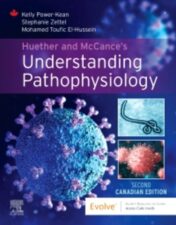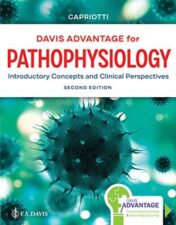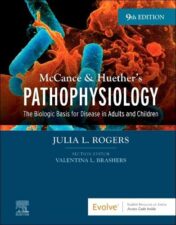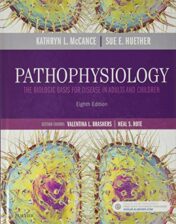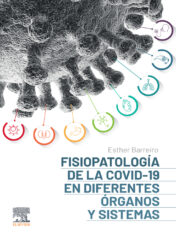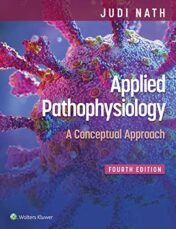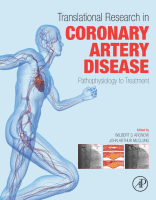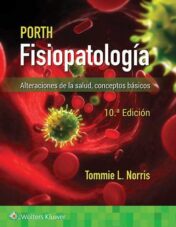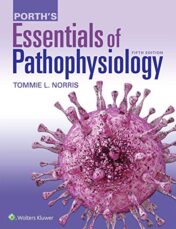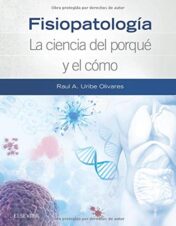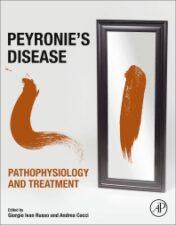Discover the Best Pathophysiology Books to Enhance Your Knowledge
Basic Sciences Books
Pathophysiology Books
Gould’s Pathophysiology for the Health Professions, 7th edition 2022 Original PDF
Pathophysiology Books
Huether and McCance’s Understanding Pathophysiology, Canadian Edition, 2nd edition 2022 Original PDF
Pathophysiology Books
Pathophysiology Books
Pathophysiology Books
Study Guide for Understanding Pathophysiology, 7th edition 2020 Original PDF
Pathophysiology Books
Mechanical Ventilation from Pathophysiology to Clinical Evidence 2022 Original pdf
Pathophysiology Books
Pathophysiology Books
Pathophysiology Books
Understanding Pathophysiology, Canadian Edition 2017 Original PDF
Pathophysiology Books
Fisiopatología de la COVID-19 en diferentes órganos y sistemas 2022 Original PDF
Pathophysiology Books
Gould’s Pathophysiology for the Health Professions, 7th Edition 2022 EPUB + Converted PDF
Pathophysiology Books
Applied Pathophysiology: A Conceptual Approach, 4th Edition 2022 EPUB3 + Converted PDF
Pathophysiology Books
Essentials of Pathophysiology for Nursing Practice 1st Ed 2021 Original pdf
Pathophysiology Books
Pathophysiology Books
Translational Research in Coronary Artery Disease Pathophysiology to Treatment 2016 original pdf
Pathophysiology Books
Pathophysiology Books
Pathophysiology Books
Porth. Fisiopatología: Alteraciones de la salud. Conceptos básicos, 10th Edition (Spanish Edition)
Pathophysiology Books
Pathophysiology Made Incredibly Easy (Incredibly Easy Series), 6th Edition
Pathophysiology Books
Pathophysiology Books
Pathophysiology of Disease: An Introduction to Clinical Medicine 8E (ORIGINAL PDF)
Pathophysiology Books
Porth fundamentos de fisiopatología, 5th Edition (EPUB + Converted PDF + AZW3)
Pathophysiology Books
Fisiopatología. La ciencia del porqué y el cómo (Spanish Edition) (Original PDF)
Pathophysiology Books
Pathophysiology Books
Pathophysiology Books
Reciprocal Translation Between Pathophysiology and Practice in Health and Disease (Original PDF)
Pathophysiology Books
Huppert’s Notes: Pathophysiology and Clinical Pearls for Internal Medicine (High Quality PDF)
Pathophysiology Books
Peyronie’s Disease: Pathophysiology and Treatment original pdf 2020
Pathophysiology Books
West’s Pulmonary Pathophysiology: The Essentials, 10th edition (ePub3+Converted PDF)
Introduction
Are you looking to enhance your knowledge of pathophysiology? If so, you've come to the right place! Here, we'll discuss some of the best pathophysiology books available and how they can help you gain a better understanding of this complex subject. From textbooks to comprehensive guides, these books provide an in-depth look at the causes, symptoms, and treatments of various diseases and disorders. With the right resources, you can become an expert in no time!
Overview of Pathophysiology: Understanding the Basics
Pathophysiology is a branch of medicine that focuses on the study of the physiological changes associated with disease. It is an important part of medical education and research, as it helps to understand how diseases affect the body and how they can be treated. Pathophysiology is also used to explain why certain treatments are effective for certain conditions.
Pathophysiology is based on the concept that all diseases have a common underlying cause. This cause is usually a disruption in the normal functioning of the body’s systems. Pathophysiology looks at the ways in which these disruptions lead to the development of disease. It also examines how the body responds to these disruptions and how it attempts to restore balance.
The basic principles of pathophysiology involve understanding the structure and function of the body’s organs and systems. This includes understanding how the body works in health and how it responds to disease. It also involves understanding the biochemical and physiological processes that occur in the body when it is exposed to disease.
Pathophysiology also involves understanding the causes of disease. This includes looking at genetic factors, environmental factors, lifestyle choices, and other factors that may contribute to the development of disease. Understanding the causes of disease can help to identify potential treatments and preventative measures.
Pathophysiology also involves understanding the signs and symptoms of disease. This includes understanding how the body reacts to the presence of disease and how it attempts to fight off the disease. It also involves understanding how the body responds to treatment and how it attempts to heal itself.
Finally, pathophysiology involves understanding the prognosis of a disease. This includes understanding the expected course of the disease and the potential outcomes. It also involves understanding the risks associated with the disease and the potential complications that may arise.
Pathophysiology is an important part of medical education and research. It helps to understand how diseases affect the body and how they can be treated. It also helps to identify potential treatments and preventative measures. Understanding the basics of pathophysiology is essential for anyone interested in pursuing a career in medicine.
Exploring the Intersection of Pathology and Physiology
Exploring the intersection of pathology and physiology is an important part of understanding how the body works. Pathology is the study of disease, while physiology is the study of how the body functions. By looking at both disciplines together, we can gain a better understanding of how diseases affect the body and how the body responds to them.
Pathology looks at the causes, effects, and treatments of diseases. It examines the structure and function of cells, tissues, organs, and systems in order to understand how they are affected by disease. Pathologists use laboratory tests, imaging techniques, and other methods to diagnose and monitor diseases. They also look at how diseases progress over time and how they can be treated.
Physiology looks at how the body works. It studies the structure and function of cells, tissues, organs, and systems in order to understand how they work together to maintain health. Physiologists use laboratory tests, imaging techniques, and other methods to study how the body responds to different stimuli. They also look at how the body adapts to changes in its environment and how it maintains homeostasis.
By exploring the intersection of pathology and physiology, we can gain a better understanding of how diseases affect the body and how the body responds to them. This knowledge can help us develop better treatments for diseases and improve our overall health. For example, by studying how the body responds to certain drugs, we can develop more effective medications. By studying how the body responds to environmental factors, we can develop strategies to prevent or reduce the risk of certain diseases.
The intersection of pathology and physiology is an important area of research that can help us better understand how the body works and how diseases affect it. By studying both disciplines together, we can gain a better understanding of how diseases affect the body and how the body responds to them. This knowledge can help us develop better treatments for diseases and improve our overall health.
Examining the Role of Genetics in Pathophysiology
Investigating the Impact of Environmental Factors on Pathophysiology
Investigating the Impact of Environmental Factors on Pathophysiology is an important area of research in the medical field. It involves studying how environmental factors, such as air pollution, water contamination, and exposure to toxic substances, can affect the development and progression of diseases. This type of research is essential for understanding the causes of disease and developing effective treatments.
Environmental factors can have a significant impact on pathophysiology. For example, air pollution has been linked to increased risk of respiratory illnesses, such as asthma and chronic obstructive pulmonary disease (COPD). Exposure to certain chemicals, such as asbestos, can increase the risk of developing cancer. Water contamination can lead to gastrointestinal illnesses, such as diarrhea and cholera. Additionally, exposure to radiation can cause genetic mutations that can lead to birth defects and other health problems.
In order to investigate the impact of environmental factors on pathophysiology, researchers use a variety of methods. These include epidemiological studies, which look at the prevalence of diseases in different populations; laboratory experiments, which examine the effects of environmental exposures on cells and tissues; and animal studies, which assess the effects of environmental exposures on animals.
Researchers also use molecular techniques to study the effects of environmental factors on pathophysiology. These techniques allow researchers to identify specific genes and proteins that are affected by environmental exposures. By understanding how environmental factors affect these genes and proteins, researchers can gain insight into how they contribute to the development and progression of diseases.
The results of research into the impact of environmental factors on pathophysiology can be used to develop strategies for preventing and treating diseases. For example, if researchers identify a particular environmental factor that increases the risk of a certain disease, public health officials can take steps to reduce exposure to that factor. Additionally, if researchers identify a gene or protein that is affected by an environmental factor, they can develop drugs that target that gene or protein in order to treat the disease.
Overall, investigating the impact of environmental factors on pathophysiology is an important area of research that can help us better understand the causes of disease and develop more effective treatments.
Analyzing the Clinical Implications of Pathophysiology
Analyzing the clinical implications of pathophysiology is an important part of medical practice. Pathophysiology is the study of how diseases and other medical conditions affect the body’s normal functioning. It involves understanding the underlying mechanisms of disease, including the biochemical, physiological, and anatomical changes that occur in the body when a disease or condition is present. By analyzing the clinical implications of pathophysiology, healthcare professionals can better understand the causes and effects of a particular disease or condition, as well as the best ways to treat it.
The first step in analyzing the clinical implications of pathophysiology is to identify the underlying cause of the disease or condition. This may involve looking at the patient’s medical history, performing physical examinations, and ordering laboratory tests. Once the cause has been identified, healthcare professionals can then begin to analyze the clinical implications of the disease or condition. This includes looking at the signs and symptoms associated with the disease or condition, as well as any potential complications that may arise from it.
In addition to identifying the cause of the disease or condition, healthcare professionals must also consider the impact of the disease or condition on the patient’s quality of life. This includes looking at the patient’s ability to perform daily activities, their emotional wellbeing, and their overall health. Healthcare professionals must also consider the potential for long-term complications, such as organ damage or disability.
Once the cause and clinical implications of the disease or condition have been identified, healthcare professionals can then develop a treatment plan. This plan should include both short-term and long-term goals, as well as strategies for managing the disease or condition. Treatment plans may include medications, lifestyle modifications, physical therapy, and/or surgery.
Analyzing the clinical implications of pathophysiology is an important part of medical practice. By understanding the underlying mechanisms of disease, healthcare professionals can better diagnose and treat patients. This helps ensure that patients receive the best possible care and achieve the best possible outcomes.
Conclusion
In conclusion, pathophysiology books are an invaluable resource for healthcare professionals and students alike. They provide a comprehensive overview of the underlying causes of disease and illness, as well as detailed information on diagnosis and treatment. With so many options available, it can be difficult to choose the best pathophysiology book for your needs. However, by considering factors such as author credentials, content depth, and user reviews, you can find the perfect book to enhance your knowledge and help you become a better healthcare provider.



